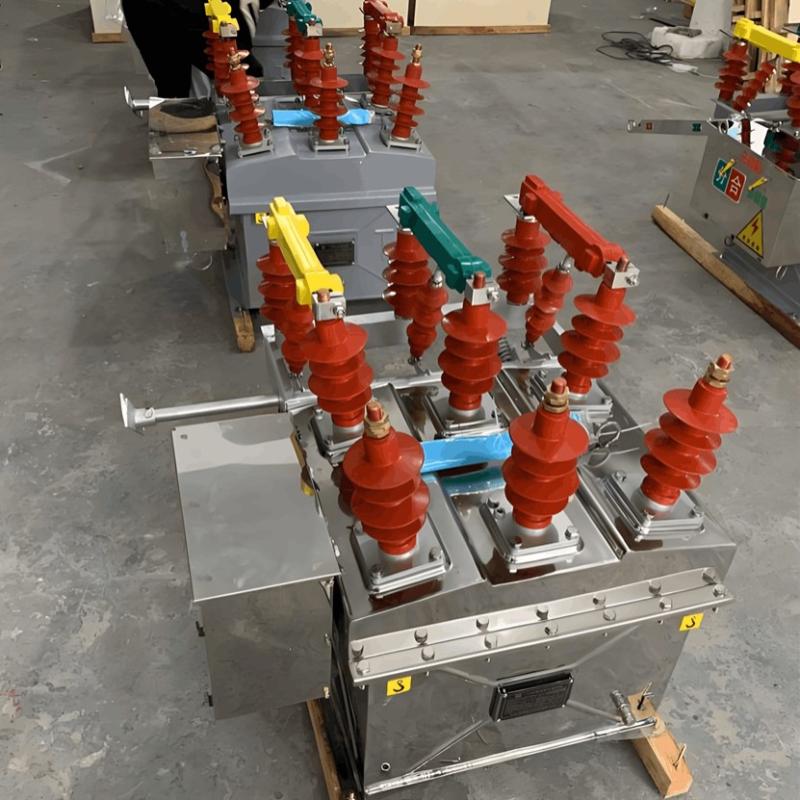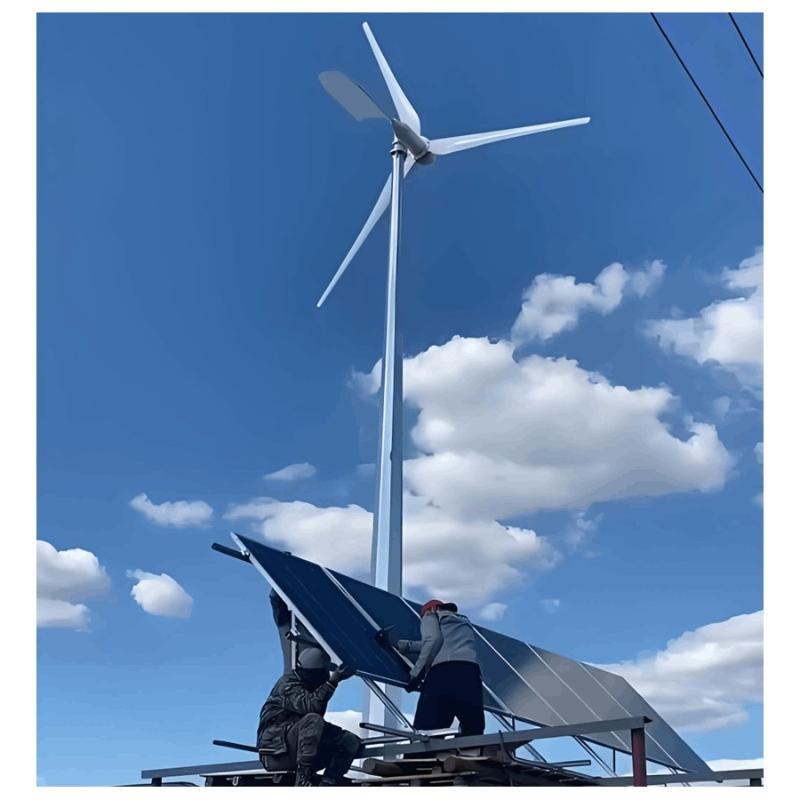Ang papel kini nagtumong sa unang paghiwa sa isang tipo sa 12kV air-insulated ring main unit (RMU) isip objecto sa pag-aaral, analisis sa distribution ug uniformity sa electric field sa palibot nito, pag-evaluate sa insulation performance sa lugar niini, ug pag-reduce sa discharge risk pinaagi sa structural optimization, tungod kay mas naaayon nga insulation performance, busa gibigyan og reference ang insulation design sa mga katul-anan nga produkto.
1 Structure of the Air-Insulated Ring Main Unit
Ang three-dimensional structural model sa air-insulated RMU nga gi-study aning paper mao ang ipakita sa Figure 1. Ang main circuit nagamit sa configuration nga nag-combine sa vacuum switch ug three-position switch, gisugyot ang three-position switch sa busbar side—usa ra maoy ang three-position switch adunay upper part sa RMU, samtang ang vacuum switch gitukod sa lower part sa solid-sealed pole structure. Tungod kay ang vacuum switch giguhit sa pole, ang exterior nian insulated sa epoxy resin, nga may sigurado kaayo nga insulation properties kaysa sa hangin, tungod kay naa na gyud ang insulation requirements.
Padayon pa, ang connection busbar sa sealing point sa solid-sealed pole nagamit sa chamfered edges ug arc-shaped design, gikombinado sa silicone rubber sealing, efektibo nga mitigating partial discharge issues sa lugar niini. Ang insulation clearances sa pagitan sa busbars ug sa ground designed batas sa relevant insulation standards ug satisfy regulatory requirements.

Ang isolation blade sa three-position switch depende sa hangin isip insulating medium. Isip movable connecting component, ang iyang structure naglakip sa metal parts sama sa pins, springs, disc springs, ug circlips aron mapadako ang contact pressure sa pagitan sa isolation contacts. Apan, tungod sa complex shapes sa mga metal parts, ang electric field distribution mahimong dili uniform, resulta sa partial discharge ug potential breakdown risks, nga makapahimo og adverse effect sa insulation performance sa lugar niini.
Tungod niini, ang electrical design sa struktura niini labi ka importante. Sumala sa product design requirements, ang isolation break kinahanglan matagbuhan sa rated short-time power-frequency withstand voltage sa 50kV, ug ang minimum designed electrical clearance sa 100mm. Tungod sa complexity sa isolation blade structure, ang grading shields giatiman sa duha ka bahin sa blade aron mapabuti ang electric field uniformity ug mabawasan ang partial discharge. Ang three-dimensional model sa three-position switch ipakita sa Figure 2. Aning paper gin-conduct ang electric field simulation analysis sa isolation break niini.
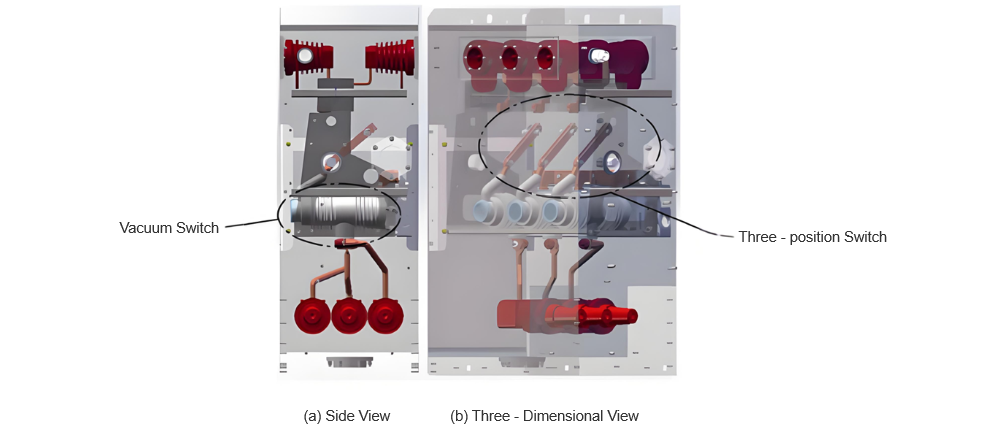
2 Simulation Analysis
Ang finite element software gipanggamit aron mogamit og electric field simulation sa ring main unit, analyzing ang electric field strength distribution sa isolation break sa specified 50 kV rated short-time power-frequency withstand voltage. Duha ka electrostatic field simulation cases giconsider:
Case 1: Ang busbar side (isolation fixed contact side) adunay low potential (0 V), samtang ang line side (isolation blade tip side) adunay high potential (50 kV).
Case 2: Ang busbar side (isolation fixed contact side) adunay high potential (50 kV), samtang ang line side (isolation blade tip side) adunay low potential (0 V).
Ang electric field distribution sa location sa maximum electric field strength alang sa duha ka cases nahatagan sa simulation. Ang electric field strength distribution sa isolation blade tip sa Case 1 ipakita sa Figure 3, samtang ang distribution sa isolation fixed contact sa Case 2 ipakita sa Figure 4. Sa Case 1, ang maximum electric field strength mahitabo sa end sa grading shield, nakarating sa 7.07 kV/mm; sa Case 2, ang maximum mahitabo sa chamfered edge sa isolation fixed contact, adunay value sa 4.90 kV/mm.
Ang typical critical breakdown electric field strength sa hangin mao ang 3 kV/mm. Tungod sa Figures 3 ug 4, habang ang electric field strength sa most areas sa isolation break wala sa 3 kV/mm—dili sulbi sa breakdown—localized regions exceed this threshold, resulta sa partial discharge. Tungod kay ang hangin mag-usab gikan sa dry hangtod sa humid conditions, ang iyang insulation capability mababa [10], mubaba ang critical uniform breakdown field strength sa wala pa sa 3 kV/mm. Padayon pa, ang highly non-uniform electric field distribution mubaba ang critical breakdown strength sa hangin, madaghan ang likelihood ug risk sa breakdown. Aron mabawasan ang impact sa external environmental factors sa air insulation medium ug mapabuti ang field uniformity, aning study evaluate ang degree sa electric field uniformity ug ang withstand voltage level sa isolation break, serving as a basis for enhancing the insulation capability of the break.
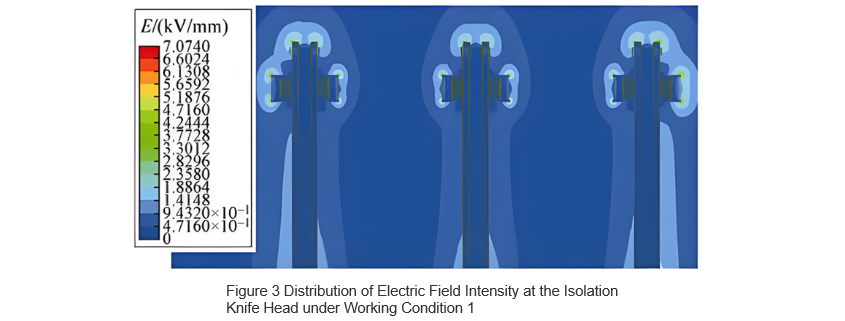
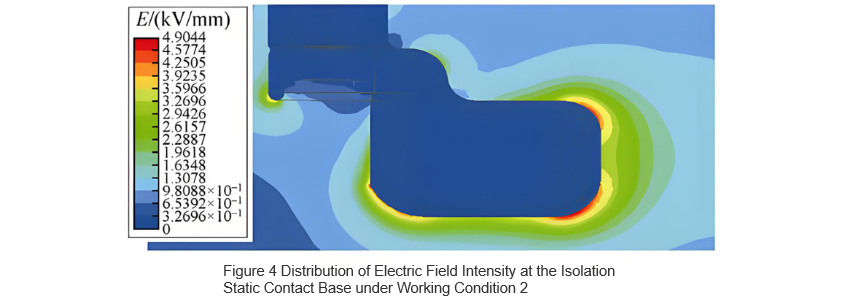
3 Air Insulation Characteristics
3.1 Determination of Electric Field Non-Uniformity Coefficient
Sa praktikal, wala gyud ang perfectly uniform electric field; tanang electric fields inherent nga non-uniform. Batas sa electric field non-uniformity coefficient f, ang electric fields klassipikahan sa duha ka types: kon f ≤ 4, ang field consider slightly non-uniform; kon f > 4, consider highly non-uniform. Ang non-uniformity coefficient f define isip f = Eₘₐₓ/Eₐᵥ, diin Eₘₐₓ ang maximum local electric field strength, gipangkuha sa peak value sa simulation results, ug Eₐᵥ ang average electric field strength, calculate isip applied voltage divided by minimum electrical clearance.
Sumala sa Figure 3, Eₘₐₓ = 7.07 kV/mm ug Eₐᵥ = 0.5 kV/mm. Busa, ang electric field non-uniformity coefficient sa isolation break mao ang f = 14.14 > 4, indicating a highly non-uniform electric field. Sa regions sa highly non-uniform fields, stable partial discharge mahimong mahitabo, ug ang mas taas ang degree sa non-uniformity, mas pronounced ang partial discharge ug mas taas ang discharge magnitude. Para sa 12 kV ring main unit, ang total partial discharge quantity sa entire cabinet required to be less than 20 pC [5,11]. Busa, mabawasan ang electric field non-uniformity coefficient helps in decreasing the partial discharge level.
3.2 Determination of Air Withstand Voltage
Ang electric field non-uniformity coefficient affects the withstand voltage of dry air. Kon ang field slightly non-uniform, ang withstand voltage mao ang:

diin U ang represent sa withstand voltage; d ang minimum electrical clearance between electrodes; k ang reliability factor, typically ranging from 1.2 to 1.5 based on experience; ug E₀ ang refer sa dielectric breakdown electric field strength of the gas. Sa praktikal, ang breakdown field strength depends sa specific configuration sa duha ka electrodes, ug ang air breakdown strength varies sa different electrode structures ug clearance distances. Para sa comparative analysis, aning paper assume E₀ = 3 kV/mm. Sumala sa Equation (1), increasing the minimum electrical clearance d ug reducing the electric field non-uniformity coefficient f can both enhance the withstand voltage of the air insulation medium.
Kon dealing sa highly non-uniform electric field, para sa electrodes sa minimum electrical clearance within the 100 mm range, ang withstand voltage calculated as follows:

Sa formula, U50%(d) ang represent sa 50% breakdown voltage sa electrode under a specific electrical clearance d during lightning impulse tests. Sa highly non-uniform electric fields, significant dispersion sa breakdown voltages ug longer discharge time lags, making the breakdown voltage highly unstable. Sa practical engineering applications, U50%(d) determined sa conducting multiple lightning impulse tests ug identifying the applied voltage where there is a 50% probability of breakdown. This value closely related sa product's structure ug the uniformity of the electric field. Established na ang lower electric field non-uniformity coefficient results sa less dispersion sa breakdown voltage, higher breakdown voltage, ug consequently, higher withstand voltage. Busa, reducing the electric field non-uniformity coefficient beneficial for enhancing the withstand voltage of the isolation break.
4 Structural Optimization
Arong mapabuti ang uniformity sa electric field sa palibot sa isolation blade tip ug mabawasan ang electric field non-uniformity coefficient, optimization sa grading shield structure gihimo. Models sa grading shield before ug after optimization ipakita sa Figure 5, samtang cross-sectional views provided sa Figure 6. Makita sa Figure 6, compared sa pre-optimization design, ang optimized grading shield features a thicker end sa rounded corners, increasing the corner radius from 0.75 mm to 4 mm. This enhancement increases the curvature radius, promoting more uniform distribution sa electric field. The electric field strength distribution sa palibot sa optimized isolation blade tip illustrated sa Figure 7. From this figure, evident na ang maximum electric field strength mabawasan sa 3.66 kV/mm, approximately half sa original value, indicating a notable improvement.
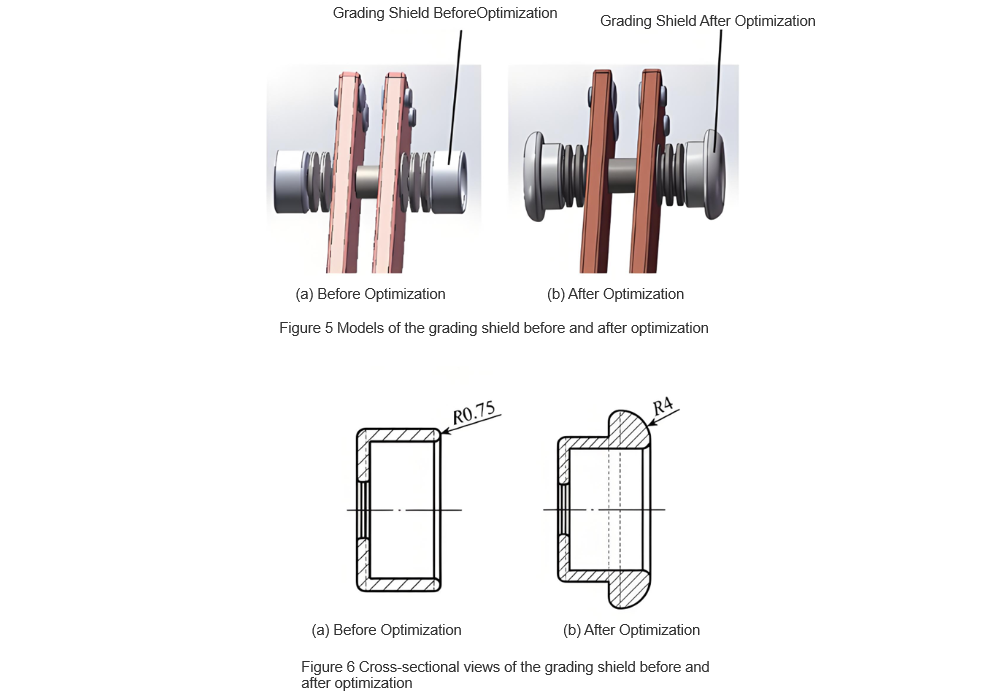
Sumala sa aforementioned formula f=Emax/Eavf=Emax/Eav, ang non-uniformity coefficient sa electric field after optimization mao ang 7.32, approximately halved compared sa before optimization.

This indicates a significant improvement sa uniformity sa electric field sa palibot sa isolation blade tip, demonstrating na ang structural optimization effective. A comparison sa data before ug after sa grading shield optimization shown sa Table 1. Makita sa Table 1, ang optimized grading shield structure indeed reduces the risk sa breakdown discharge sa pagitan sa isolation breaks. Apan, ang electric field sa pagitan sa isolation breaks remains highly non-uniform, meaning its withstand voltage still determined sa U50%(d)U50%(d). The extent of improvement sa withstand voltage can be further confirmed through on-site testing.
Aning translation maintains the technical details ug context provided sa original text, ensuring clarity ug accuracy for an English-speaking audience.

5 Experimental Verification
Arong validate the effectiveness sa simulation analysis, partial discharge tests conducted sa 12 kV air-insulated ring main unit. Tulo ka prototype units (No. 1 to No. 3) prepared. Partial discharge tests first performed sa original (pre-optimization) grading shields installed sa isolation blades sa tulo ka units. Subsequently, ang optimized grading shields installed, ug ang tests repeated. Ang resulting partial discharge data presented sa Table 2.
Makita sa table, ang partial discharge levels before optimization all exceeded 20 pC, samtang those after optimization mabawasan sa below 4.5 pC. This indicates na ang optimized grading shield structure effectively enhances the insulation performance sa ring main unit ug confirms the validity sa preceding simulation ug analysis.

6 Conclusion
Based sa electric field analysis sa isolation break sa 12 kV air-insulated ring main unit, ang following conclusions drawn:
Tungod sa insulation capability sa hangin inferior sa SF₆, improving electric field distribution essential aron mapabuti ang insulation performance kon hangin ang gamiton isip insulating medium sa three-position switches sa ring main units.
Tungod sa structural complexity sa moving components (isolation blades) sa three-position switches sa air-insulated ring main units, ang electric field strength distribution sa certain locations mahimong highly non-uniform. Aron mabawasan ang non-uniformity, grading shields can be added sa duha ka bahin sa isolation blade aron shield ang high-field regions near sa blade's connecting parts, thereby shifting ang location sa peak field strength sa ends sa grading shields. Sa study, increasing the curvature radius sa shield's end from 0.75 mm to 4 mm reduced both the maximum local electric field strength ug the electric field non-uniformity coefficient sa approximately half sa original values, achieving the desired optimization effect.
Ang uniformity sa electric field distribution, o ang electric field non-uniformity coefficient, significantly influences partial ug breakdown discharges. Highly non-uniform fields tend to produce stable partial discharge (corona discharge). Sa both slightly ug highly non-uniform fields, a higher non-uniformity coefficient results sa lower withstand voltage sa pagitan sa electrodes.




















